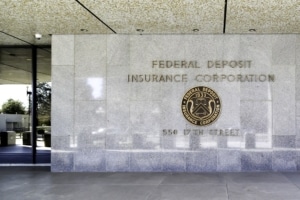[ad_1]
How properly are you aware your financial institution? As we’ve not too long ago discovered with the high-profile collapses of Silicon Valley Financial institution (SVB) and New York-based Signature Financial institution, monetary establishments are usually not infallible. If their collapses show something, it’s that every time your small enterprise deposits cash or in any other case does enterprise with a financial institution, you run the chance of your financial institution collapsing and shedding any cash past $250,000 (the quantity insured by the federal authorities) that you might have tied up in that financial institution.
Wall Road has a elaborate time period for all this – systemic danger. This danger is nearly handled as an summary danger since banks don’t collapse fairly often – the autumn of SVB and Signature marked the primary time monetary establishments collapsed for the reason that Nice Recession started in 2008 – however the way in which the 2 banks collapsed, and the way rapidly they collapsed, ought to remind everybody that doubtful funding selections and altering market situations might result in your financial institution’s insolvency. Most significantly, the collapses are as soon as once more a stark reminder that systemic danger shouldn’t be seen as summary, however as a really actual danger.
What Occurred and Why is it Vital?

Silicon Valley Financial institution’s sudden collapse ought to immediate SMB house owners to take an in depth take a look at their very own banks.
SVB’s collapse was induced, partly, to investing a lot of its deposits in US Treasury bonds. When rates of interest have been hiked, the worth of these bonds plummeted, setting off a domino impact: SVB, quick on liquidity, offered these bonds at large losses, prompting clients to hunt to withdraw their cash en masse. This induced the financial institution to break down and the Federal Deposit Insurance coverage Corp. (FDIC) to take over to make sure that clients obtained their a reimbursement.
Signature Financial institution, whose clients included Silicon Valley startups in addition to high-margin small companies in the actual property and authorized professions, confronted a cascade impact when SVB collapsed. Based on regulatory filings, almost 90% of its $88 billion in deposits have been uninsured, which means that almost all of its clients had greater than $250,000 in holdings with the financial institution (keep in mind, the FDIC solely insures as much as $250,000).
Each Signature and SVB have been additionally one of many few banks to tackle cryptocurrency deposits. Cryptocurrency companies comparable to Bitcoin have been steadily declining for roughly a 12 months.
Not ‘Too Large to Fail’
All of us discovered from the 2008 monetary disaster that monetary establishments aren’t ‘too large to fail’ as they as soon as claimed. The identical goes true for regional and native banks, and the collapses of SVB and Signature Financial institution show that. Collapses are contagious as properly. If one financial institution collapses, clients of different comparable banks might panic and need to take their cash out.
Many Signature Financial institution clients panicked after SVB’s collapse and sought to withdraw their money en masse – a horrible state of affairs for banks since most banks sometimes don’t have all of the money readily available to again up all the cash that their clients have entrusted them with. New York banking regulators and the FDIC took over the financial institution to guarantee clients that their cash, uninsured or not, was nonetheless obtainable to them.
What Ought to You do?
The underside line: This case ought to underline the very fact for small enterprise house owners that you just at all times have to be looking out for indicators that your financial institution is in hassle. In any case, banks have the proper to scrutinize you, the small enterprise proprietor, everytime you ask for a mortgage. Conversely, you’ve each proper to scrutinize your financial institution by at all times being looking out for indicators that it will not be financially wholesome earlier than you belief them to carry your hard-earned cash.
This, after all, doesn’t imply that it’s best to disguise your small enterprise’s money reserves beneath your mattress. You may, nonetheless, maintain a guidelines of issues to look at for to verify your funds are protected in your financial institution.
#1 Verify the Share Worth
In 1999, the federal authorities repealed a long-standing set of banking laws that shaped the Glass-Stegall Act, thus permitting financing establishments to be publicly traded. As soon as the repeal took impact, it wasn’t simply massive monetary establishments that went public, however many regional and native banks went public as properly. A fast look at your financial institution’s share value ought to provide you with a fast snapshot of its monetary well being, if its shares drop out of the blue, it might point out that there’s an issue.
#2 Is Your Financial institution FDIC Insured?
It’s best to solely deposit your small business’ cash in banking establishments which are FDIC insured. Nearly

The FDIC solely insures as much as $250,000 per particular person or enterprise, so ensure you maintain your cash in a number of banks if obligatory.
each respected financial institution is, however it’s price ensuring anyway.
#3 Is Your Financial institution Promoting Property?
It’s best to examine the information on occasion to see in case your financial institution is taking any actions indicating that it might have liquidity issues. For instance, if in case you have a mortgage along with your financial institution and also you out of the blue see that it’s being serviced by one other establishment, it might point out that your financial institution has offered some or all of its mortgage portfolio to be able to make fast cash. Whereas this isn’t at all times the case, promoting property might imply that your financial institution is operating out of money, so this could act as a reminder to only look somewhat deeper.
#4 Is Your Financial institution Making Cuts?
Is your financial institution actively making an attempt to economize? In case your financial institution is taking actions comparable to closing branches, shedding employees, and eliminating cash-back rewards or different incentives, it might point out that it’s hemorrhaging money.
#5 What Does Your Financial institution Spend money on?
Banks maintain the insured parts of deposited cash in FDIC banks to realize curiosity, in addition to a portion of it in an on-site financial institution vault to deal with buyer withdrawals. Banks can even make investments a portion in shares, bonds and actual property as a approach to earn more money. In case your financial institution is publicly traded, chances are you’ll need to take a look at its most up-to-date annual report (kind 10K), which ought to reveal what it’s investing in. In case your financial institution is investing in high-risk property, then it may very well be in danger for a liquidity crunch if these investments go south.
#6 How is Your Financial institution Rated?
The FDIC retains a operating checklist of banks it considers to be problematic, however isn’t obligated to make that checklist public. Nonetheless, Weiss Financial institution Rankings charges banks and largely makes use of the identical tips because the FDIC in figuring out high-risk banks.
#7 Are you Diversified?
If you happen to personal a high-margin small enterprise comparable to a physician’s workplace or legislation or accounting agency and have greater than $250,000 in money reserves, your finest wager is to diversify the checklist of banks through which you deposit your cash in order that no single establishment has extra money than what’s federally insured.
Keep Vigilant
In case your financial institution does collapse, getting your a reimbursement may very well be a protracted course of, even when it’s FDIC insured. Subsequently, it’s vital to do your analysis on any financial institution that you’re in search of to do enterprise with. Preserve a guidelines of things to look at for that would point out that your financial institution is having liquidity issues.
[ad_2]